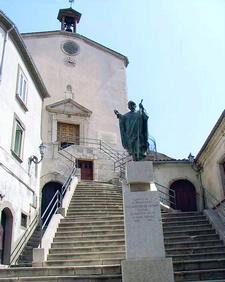
S. Maria Della Quercia Main Entrance
Statue of St. Jacobis in foreground
S. Maria Della Quercia or Holy Mary of the Oaks

S. Maria Della Quercia Main Entrance
Statue of St. Jacobis in foreground
by Thomas Frascella
San Fele’s largest Church, its Cathedral, is called S.
Maria Della Quercia or in English Holy Mary of the Oaks. The Church was built in
the early 1500’s . Construction of the Church was started around 1514 as a
replacement for San Fele’s first Church, St. Sabastiano, which was destroyed in
the earthquake of 1456. This makes the new Church in the town 500 years old.
Palazzo Frascella now occupies the former site of St. Sabastiano and the Church
of S. Maria Della Quercia is located at a slightly lower elevation on the
mountain top at a location that is the junction of two of the three mountain
peaks upon which the town is built. The new location has served well and has
brought the Church safely through many earthquakes in the past five centuries.
Through the centuries San Fele and many small towns in the region have responded
to severe earthquake damage by rebuilding structures lower on the mountain
sides. Some towns like San Fele completely removed the ruined upper level
buildings and some towns have simply left their ruins abandoned.
The name of the Church has an interesting history in Italy. In 1417 a painting on tile of the Madonna and child was commissioned by a citizen to the town of Viterbo in central Italy near Rome. When the tile was completed it was affixed by the owner to an oak tree in the town. In 1467 during one of the repeating generational outbreaks of the plague the image became an object of veneration to which many miraculous cures were associated.
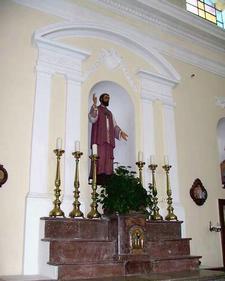
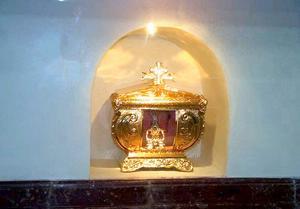
Statue
of St. Jacobis
Gold chest holding relic of St. Jacobis
Upon hearing of the miracles at the initiative of Pope Sixtus IV a Church dedicated to the Madonna was built in Viterbo and completed between 1471 and 1525. The church was called S. Maria Della Quercia and continues to exist to this day. The church has enjoyed the patronage of many Popes through the centuries starting with Pope Sixtus (1471-1484) and his nephew Pope Julius III (1503-1513). Coincidentally both these Popes bore the surname Della Rovere which means “of the oaks”. Among the later Popes who were patrons was Pope Innocent X (1644-1655) a Pamphili whose family had a palace in Viterbo and who also was successor to the title Prince of Melfi.
The Viterbo Church also has attached a Dominican monastery started in the late 1400’s. The Dominicans founded the Society of Gloriosa Vergine Maria Della Quercia at that location to manage the many pilgrims who visit the site annually. The original church and monastery in Viterbo are familiar to most people who have seen the movie “Godfather III” as it was the location backdrop for the scene in the movie where an aging Michael receives absolution from the soon to be elected Pope.
A strong connection to Mary as San Fele’s patroness and the many reported 15th century miracles associated with the S. Maria Della Quercia Tile in Viterbo I am sure drew the attention of our ancestors as they constructed their new Church in San Fele. The history of the Viterbo Church probably resulted in the San Fele Church being given the same name as that of the Church in Viterbo. There are very few other Churches that share this particular name in Italy.
I think it impressive that San Fele’s “Cathedral” was constructed during a period that followed several major plagues, losses in war, economic collapse from loss of trade with the middle East and natural earthquake disasters. In the midst of what must have been one of the lowest points in the community’s history the expenditure in both labor and capital that they put forth in order to build this Church is an extraordinary expression of faith. Historically the period following the building of this Church is connected to what I would describe as a period of renewed spiritualism in both the town and the area. In the following centuries there are an impressive number of people connected to the town and the region who rose to positions of significant note in the Church. In fact the following centuries could be said to be San Fele’s age of saints.
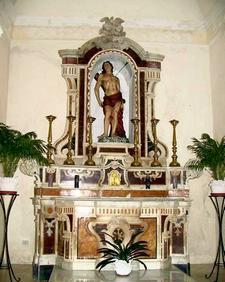
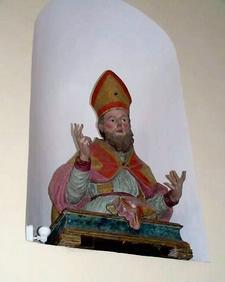
Statue of St. Sabastian Statue
of St. Nickolas
Very little of the ancient art work that has adorned the churches of San Fele”s Churches has managed to survive the many earthquakes that have struck the region over the past 600 years. Major earthquakes, those registering over 6.5 on the Richter Scale have caused widespread property damage and thousands of regional deaths. Major earthquakes have been occurring over the last 600 years at intervals of between 40 and 100 years in the Vulture region. The last major earthquake measuring 6.8 occurred in 1980. Lesser earthquakes occur more frequently.
Within San Fele’s Church of S. Maria Della Quercia can be found a number of statues reflecting the town’s heritage. Two statues reflect those that were originally in the Church of St Sabastiano one honoring St. Sabastiano, himself, for whom the original San Fele Church was named in the 11th century and the other St. Nicholas of Bari. These two statues represent depictions of saints that where of particular importance to our Norman ancestors. In the Norman/Italian tradition of the 11th century St. Sabastiano and St. Nicholas held a special place in the culture and therefore a place of honor in San Fele’s 11th century first church.
St. Sabastiano is often depicted tied to a stake and pierced with arrows, the method of his first execution. This depiction is what is shown in San Fele’s Church. Legend had it that his faith protected him at the time of his first martyrdom and he miraculously survived the numerous wounds. Undoubtedly the belief that his faith and nothing more protected him from the certain death of the arrows had great appeal to a warrior culture like that of the Normans which often found its ranks facing the wrong end of similar piercing onslaughts. As a result St. Sabastiano images can be found in many Norman influenced Churches.
St Nicholas is also present and is also a favorite among the 11th century Normans. According to tradition the body of St. Nicholas, a third century bishop in Asia Minor was originally entombed in a small town in what today is Turkey. Around 1088 AD Italian Normans raiding the coast of the Byzantine Empire entered the town and realized an opportunity to obtain some of the transportable treasures of the area. The religious term for removing a holy object is called translation. The Byzantine Empire had all of the best Christian relics and the Normans decided to translate the Bishop’s final resting place to
the port city of Bari in southern Italy. Normans did a lot of translating from the Byzantine and Palestinian region then and throughout the period of the Crusades. The Normans treated the remains with great respect and built a Cathedral in Bari to house the relic. From that point forward the Italians have referred to St. Nicholas as St. Nicholas of Bari. The Turkish government continues to demand the remains to this day.
S. Maria Della Quercia in San Fele also contains a statue of St. Jacobis inside as well as in the square immediately outside the Church. Inside the Church are housed relics of that native saint. St. Jacobis’ body is entombed in a Church in Ethiopia where he died for the faith in the 1850’s.
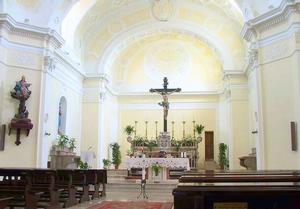
Statue of Mary of the Oaks to the left of main altar in the church.
Of interesting note there is also a statue of the San Fele
Church of the Madonna of the Oak for whom the Church is named. The statue’s
execution is however an interesting departure from the rendition in Viterbo. In
Viterbo the Madonna figure is a head and shoulder portrait of an uncrowned Mary
and infant Christ child. The child is on Mary’s right side and the depiction is
consistent with15th and 16th century artistic traditions. The San
Fele depiction is substantially different from the Viterbo portrait. First, it
is a statue not a painting and it is of a crowned Mary standing centered above
the trunk of the Oak tree with the branches ascending around her. This depiction
is rather unique to San Fele and not a part of the mainstream art of the period.
The depiction seems to recall artistic traditions which are vastly older than
the century of its construction. The statue suggests yet another example of
local Basilicatan art blending widespread cultural and period traditions into an
expression of faith that encompasses rather than excludes the multi ethnic
heritage of the region.
© San Felese Society of New Jersey